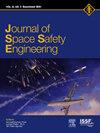对近期碎片生成事件的取证分析
IF 1.7
Q3 ENGINEERING, AEROSPACE
引用次数: 0
摘要
每一次在轨碰撞或爆炸不仅会对现有卫星群造成威胁,还会对地球轨道的长期可用性造成威胁。即使卫星能够主动机动以避开可跟踪的碎片,这种威胁也是存在的,因为据估计,96%可能危及飞行任务(1 厘米)的碎片是无法跟踪的[1]。防止每一次在轨碎裂可能是不可能的。但是,如果了解了碎片事件的可能原因,卫星开发商和运营商就可以采取行动,在未来减少此类事件的发生。天体动力学法证分析是一种用于收集事件已知细节和估算未知参数的侦查技术,可用于发展有关碎裂原因的理论并预测其后果。在过去五年中,发生了多起在轨碰撞和爆炸事件,涉及各种轨道物体,其可用观测数据量各不相同。美国航空航天公司数十年来开发的技术和工具被用来描述这些事件的关键参数,包括碎片的扩散速度、解体事件涉及的能量以及单个碎片的质量和面积估算。通过利用从不同类别的历史断裂和地面测试数据中识别出的模式,这些取证能力得到了增强。本文展示了这一方法在用于分析各种类型事件时的有效性,包括碰撞(如宇宙 1408 反卫星试验和 SL-14 火箭本体破裂)、火箭本体碎片(如 2022 年长征 6A 号火箭本体破裂)和卫星碎片(如 Resur-O1 号卫星本体破裂)。利用 IMPACT 破碎工具开发了具有代表性的事件模型,并对可跟踪轨道碎片的寿命进行了预测。在事件来源不明的情况下,利用碎裂参数和趋势来提出可能的原因。还讨论了在观测线索很少的情况下分析轨道碎裂之谜所面临的挑战。本文章由计算机程序翻译,如有差异,请以英文原文为准。
Forensic analysis of recent debris-generating events
Every on-orbit collision or explosion can pose a threat, not only to the existing satellite population but also to the long-term usability of Earth orbit. This threat exists even if satellites can actively maneuver to avoid trackable debris fragments, since an estimated 96 % of potentially mission-ending (>1 cm) debris is untrackable [1]. Prevention of every on-orbit breakup may not be possible. However, armed with an understanding of the likely causes of fragmentation events, satellite developers and operators can take actions to mitigate such events in the future. Astrodynamics forensic analyses, the sleuthing techniques used to gather an event's known details and estimate its unknown parameters, can be used to develop theories about the causes of a breakup and to predict its consequences.
In the past five years, several on-orbit collisions and explosions have occurred, involving a variety of orbiting objects with varying amounts of available observational data. Techniques and tools developed over decades at The Aerospace Corporation are used to characterize key parameters of these events, including spread velocity of the debris pieces, energy involved in the breakup events, and mass and area estimates of the individual debris fragments. These forensic capabilities are enhanced by utilizing patterns identified from different classes of historical breakups and ground-test data. This paper shows the effectiveness of this methodology when used for analysis of a variety of event types including collisions, such as the Cosmos 1408 ASAT test and SL-14 rocket body breakup, rocket body fragmentations such as the 2022 Long March 6A breakup, and satellite fragmentations such as the Resur-O1 breakup. Representative models of events are developed using the IMPACT fragmentation tool, and predictions of the lifetimes of the subtrackable orbital debris are included. Where event sources are unknown, breakup parameters and trends are used to suggest possible causes. The challenges of analyzing an orbital breakup mystery with few observational clues are also discussed.
求助全文
通过发布文献求助,成功后即可免费获取论文全文。
去求助
来源期刊

Journal of Space Safety Engineering
Engineering-Safety, Risk, Reliability and Quality
CiteScore
2.50
自引率
0.00%
发文量
80
 求助内容:
求助内容: 应助结果提醒方式:
应助结果提醒方式:


